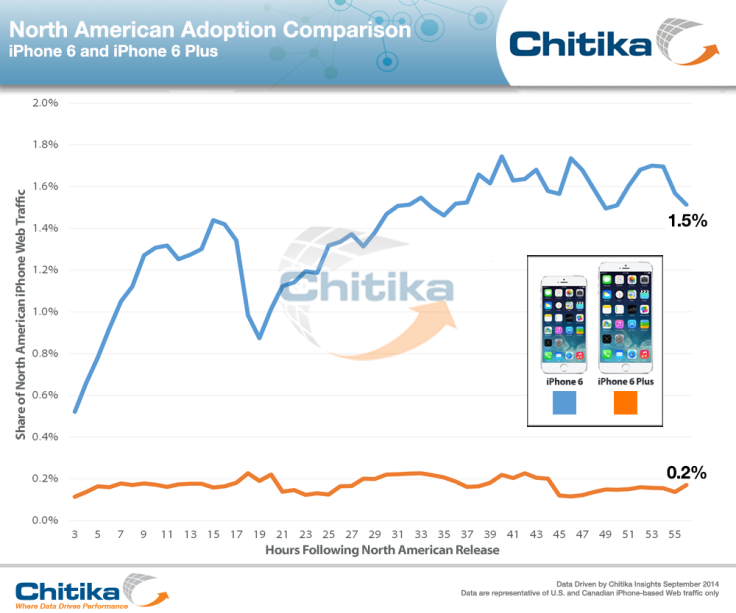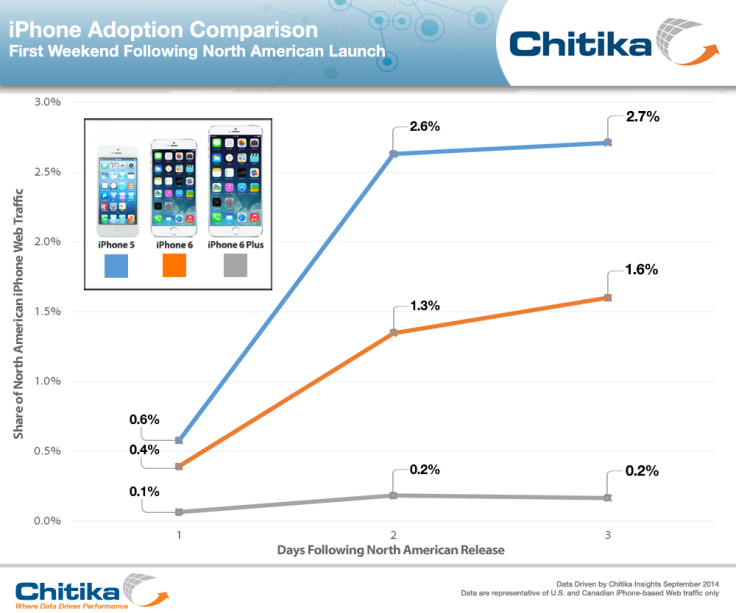Apple iPhone 6, iPhone 6 Plus Adoption Rate In US Slower Than That Of iPhone 5 After First Weekend

While Apple’s latest iPhone 6 and iPhone 6 Plus have been received exceptionally well in the United States, the phones' initial adoption rates after the first weekend have been slower than that of the iPhone 5 in a comparable time period, according to a new report.
The initial usage growth for the 4.7-inch iPhone 6 has been impressive while the 5.5-inch iPhone 6 Plus is trailing its smaller counterpart. However, the early adoption rates of both devices are slower than that of the iPhone 5 because of supply delays, online ad network Chitika said in a report. The new iPhone models, which were released across the U.S., Canada and several other countries on Friday, garnered more than 4 million pre-orders in the first 24 hours after they became available, helping book nearly twice as many pre-orders as the iPhone 5 did in 2012.
To provide details about usage growth on the iPhone 6 and iPhone 6 Plus, Chitika examined millions of U.S. and Canadian iPhone-based online ad impressions that were generated between Sept. 19 and Sept. 21.

According to the firm, iPhone 6 users surpassed a 1.5 percent usage share less than two days after the Sept. 19 launch of the device. That figure is nearly one percentage point behind what was observed for the iPhone 5 over the same time period following its public release. But, it is significantly more impressive than the Samsung Galaxy S5, which took more than a week to generate a 1.5 percent share of Samsung smartphone web traffic.

“The iPhone 6 Plus exhibiting a slower growth rate isn’t a tremendous surprise due to the phone’s size giving it more of a niche appeal as opposed to the 4.7-inch iPhone 6,” the Chitika report said. “Additionally, while supply delays have impacted the ability to meet demand for both devices, the iPhone 6 Plus has been selling out at retail stores much more frequently than the traditional model.”
Apple has not so far provided a country-specific breakdown of its record-setting iPhone 6 pre-orders. However, according to Chitika, it can be assumed that a considerable percentage of those purchases were made by consumers in the U.S. and Canada.
The early adoption rate for the iOS 8 has also been slower than that of its two predecessors -- iOS 7 and iOS 6. According to Chitika, iOS 8 was running on about 7.3 percent of iOS devices 24 hours after it was released. In comparison, iOS 7 was installed on 18.2 percent of devices after the first day of its availability while iOS 6 was running on 14.8 percent of devices within 24 hours of its release.
© Copyright IBTimes 2024. All rights reserved.






















